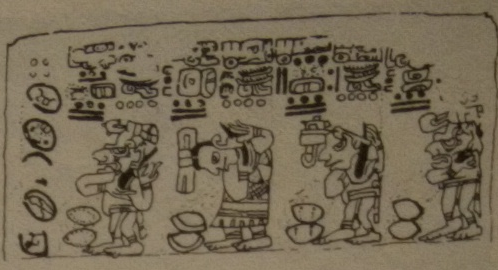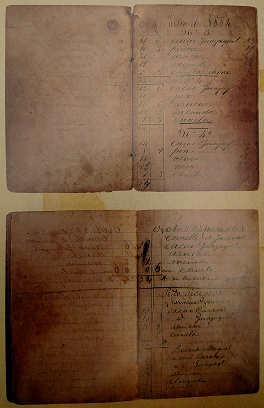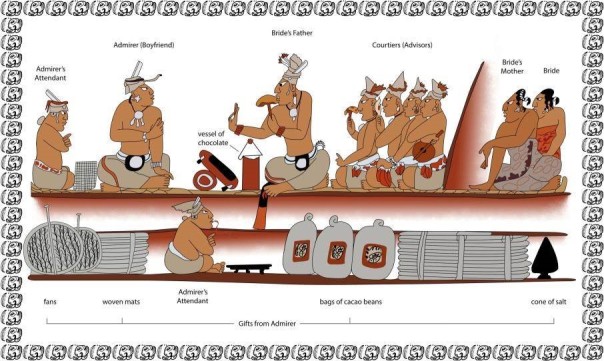
Today, chocolate is widely known as a nice treat to eat, and a delicious beverage. The focus of this essay is on chocolate beverages. The many different modern recipes we know today of how to make and drink chocolate are important to us, because they yield delicious beverages. Usually, no second thought is given as to why we have been able to enjoy such recipes during modern times. The tradition of enjoying chocolate had to have begun somewhere and sometime ago to be able to have carried on into today. As is apparent by the photo and caption above, ancient Mesoamericans (in the case of the photo, the Mayas) greatly adored chocolate. In fact, the ancient Aztec, Mixtec, and Olmec peoples also had opportunities to enjoy chocolate during chocolate’s early history. Perhaps, the meaning behind the term, “food of the gods,” referring to chocolate, was taken more seriously in ancient times, allowing for progression of the custom (qtd by C. Martin “Mesoamerica”). By analyzing the historical accounts of ancient chocolate recipes and their social importance, we can see that the chocolate we know today has important underlying history.
Simply carrying on the tactful, thousands-of-years-old practice of experimenting with chocolate recipes that people often do today has historical importance.

The discovery of chocolate is thought to be credited to the ancient Olmecs, who lived between 1200 BC and 300 BC along the southern Gulf coast of Mexico. The Olmec society evidently laid the foundation for the barely more recent Maya civilization (Presilla 9). Even though chocolate was discovered by the preexisting Olmecs, many historical traditions and customs surrounding chocolate have been developed by the succeeding Mayans, Mixtecs, and Aztecs. Some of the traditions that were developed by the ancient Mesoamerican groups are still culturally important today. Chocolate was involved in wedding rituals, death rituals, and celebrations. An important celebration in modern times, Dia de los Muertos, is a celebration that can be celebrated with chocolate beverages (C. Martin “Mesoamerica”). The variety of uses for chocolate is what really helps to portray how important chocolate really was to the ancient Mesoamericans.

In past and present cultures, great care is/was taken to make exceptional, authentic chocolate beverages. In modern times, many of us are used to preparing hot chocolate with a simple and quick recipe that includes a mix especially for adding to warm milk or water before being whisked or stirred together. Contrary to our well-known capitalistic version of hot chocolate, we might sometimes find people preparing recipes from scratch, as we can see in the video:
https://www.youtube.com/watch?v=GlAg7zIR57k
Per authentic Mesoamerican recipes, cacao beans are roasted, shelled, and ground into chocolate liquor. Most authentically, the chocolate liquor is added to warm water, usually along with regional spices. Regional flavors added to chocolate beverages include: “nuoc mam of Southeast Asia, the chili peppers (Capsicum species) of Mexico, West Africa, and parts of India and China, the sofrito of the Hispanic Americans, and so on” (Mintz 11). The care taken to prepare chocolate maintained its popularity, and allowed for continual use in modern times. Depending on the authentic recipe, there are certain ways to ensure that the chocolate drink is enjoyed with foam. For example, a molinillo could be used, or another way to create foam would be to continuously pour the chocolate between containers until foam forms (Cartwright). The “foam” tradition is seemingly unknowingly continued today with the use of marshmallows and whipped cream!

As it is apparent, there are many ways in which the chocolate we know today has important history behind it. Of course, the original chocolate recipes have all been subject to variation throughout time. What is most important for someone who aspires to learn and appreciate chocolate is to understand its history, and appreciate the reasons behind the uses of such a delicacy. And the next time we decide to consume a chocolate beverage, we will have a better understanding of its historical origin in more technical terms than just thinking that, “such and such company processed this chocolate and distributed it in pouches before I bought it.” Perhaps, our better understanding of chocolate history will allow us to appreciate the chocolate beverages more than we previously have appreciated them.
Works Cited
Cartwright, Mark. “Chocolate.” Ancient History Encyclopedia. Creative Commons: Attribution-NonCommercial-ShareAlike, 27 June 2014. Web. 09 Mar. 2017. <http://www.ancient.eu/Chocolate/>.
Coe, Sophie D. and Michael D. Coe. The True History of Chocolate. Third Edition. Thames &Hudson Ltd: London, 2013. Print.
Martin, Carla D. “Chocolate Expansion.’” Chocolate, Culture, and the Politics of Food. Harvard Extension School: Cambridge, MA. 8 Feb. 2017. Class Lecture.
Martin, Carla D. “Mesoamerica and the ‘Food of the Gods.’” Chocolate, Culture, and the Politics of Food. Harvard Extension School: Cambridge, MA. 1 Feb. 2017. Class Lecture.
Mintz, Sidney W. Sweetness and Power. New York: Viking Penguin, 1985. Print.
Presilla, Maricel E. The New Taste of Chocolate Revised. Ten Speed Press: Berkeley, CA, 2009 Print.
The Sunday Supper Project. “Preparing Drinking Chocolate near Oaxaca, Mexico.”YouTube.YouTube, 25 Apr. 2010. Web. 09 Mar. 2017. <https://www.youtube.com/watch?v=GlAg7zIR57k>.



You must be logged in to post a comment.